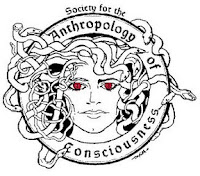The Society for the Anthropology of Consciousness is affiliated with the American Anthropological Association, and since 1990 has published a quarterly refereed journal, Anthropology of Consciousness. Members of the Society investigate cultural manifestations of psychological phenomena of all sorts — awareness, attention, memory, mood, feeling, intention, volition.
 |
“Anthropologists have always given implicit or explicit acknowledgment to these phenomena,” writes Stanley Krippner, “but in the Society for the Anthropology of Consciousness, we have made them the major focus of our research into the belief systems and evolution of human societies and the individuals, families, kinship groups, and ethnic conglomerates they encompass.” As one announcement puts it, the aim of the SAC is to “provide a forum for the exploration of consciousness from cross-cultural, experiential, and theoretical perspectives.” The SAC also hosts sessions at the annual meetings of the American Anthropological Association.
The 2007 annual meeting of the American Anthropological Association took place in Washington, DC, from November 28 to December 2, and the Society for the Anthropology of Consciousness was there. Barbara Tedlock, of the Department of Anthropology at SUNY Buffalo, organized and chaired an invited session called Writing Shamanism Today in Theory and Practice. Here is the description:
Use of the word shamanism in North America has changed greatly over the past hundred years. In the late-nineteenth century the term was used in a curious but disbelieving manner by anthropologists, including Franz Boas, Alfred Kroeber, and others, to describe a Native American spiritual phenomenon. Great attention was given by scholars of the time to the theatricality of shamans’ performances and to the genuineness, or lack of genuineness, in their trance states. In the past twenty years, due to the rapid development of complimentary and alternative medicine (CAM), which incorporates various shamanic techniques or modalities into mainstream healthcare practice, shamanism has taken on a new and rather different set of meanings. Today scholars are also interested in understanding the universality, cross-cultural and gendered manifestations, and contemporary resurgence of shamanistic phenomena in terms of globalization, tourism, information processing, and psychosocial formations. This session explores the ever changing terrain in “writing shamanism,” including attitudes towards and multiple scholarly approaches to shamanism from Mongolian shamans’ toolkits, which act as virtual maps of the spirit world; Malaysian and Korean performative practices; neoshamanic Wiccan traditions, Celtic Druidic shamanic-journey tales, and Ayahuasca use by Santo Daime churches worldwide; Asian and Native American bioenergetic healing; and Zuni medicine society magicianship that heals and re-enchants the world.
The papers presented included Barbara Tedlock on shamanic bioenergetic healing within integrative medicine, Marilyn Walker on the shaman’s tool kit in Northern Mongolia, Dennis Tedlock on the shaman as magician, Beth Savage on modern Celtic shamanism, Lori Thayer on the adoption of shamanic healing in Western medicine, and Marc Blainey on entheogens and neoshamanism.
I will post any information I receive about the publication of these papers.
The Spring 2008 meeting of the Society for the Anthropology of Consciousness will be held at the Yale Divinity School from March 19-23, 2008.
You can get really neat T-shirts with various SAC logos here.

- Previous Post: Hallucinogen Studies in Animals
- Next Post: Extraordinary Anthropological Experiences
- More Articles Related to: Shamanism


